May 6. FES The sun finally decided to shine on Fes. We got up early to get out and make the most of it. We went over to new town to find breakfast but it didn't really turn out to be worth the effort. Rob received his fried egg floating in two inches of oil. We planned to visit a nearby village for their weekly souk (market) but the transport information in our guidebook turned out to be wrong. The only option we were given to reach this other town was to take a taxi and that would have been expensive. Somewhere we knew there had to be local transport since it was unlikely that everyone went to the market via taxi but nobody seemed incline to tell us where to go. We were tourists so we should just fork out for a taxi. In the end we just bagged our plans and returned to the medina. inches of oil. We planned to visit a nearby village for their weekly souk (market) but the transport information in our guidebook turned out to be wrong. The only option we were given to reach this other town was to take a taxi and that would have been expensive. Somewhere we knew there had to be local transport since it was unlikely that everyone went to the market via taxi but nobody seemed incline to tell us where to go. We were tourists so we should just fork out for a taxi. In the end we just bagged our plans and returned to the medina.
From the west gate we took the other main pathway through the walled city. It started out as a local market, full of fruit and vegetable vendors, butchers shops, and various other food items. The street was partially shaded by woven mats that had been stretched from roof to roof. Goat heads looked at us as we passed the butcher shops, a cow jaw was getting kicked around on the ground. I nearly slipped and fell when I accidentally stepped on it. As the street descended down the slope into the heart of the medina it passed some old fountains, mosques, bath houses, and then finally ended up in the same mass of tourist shops that clustered where the two main streets converged and everything started to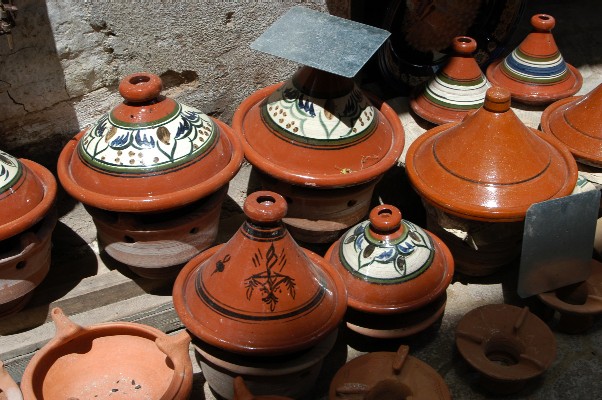 veer around the large mosque. By now it was all starting to feel a bit familiar and we found our way to the henna souk, which actually sold more blue and white pottery than henna anymore. We dipped into the Nejjarine Museum, a restored funduq, a kind of lodging used at one time for travelers, the bottom having room for the horses and the top floors for the guests. It had a worthwhile exhibit of tools, weapons and other items but the highlight was the rooftop where we could see out over the top of the medina. They had a small cafe there where we drank some mint tea. veer around the large mosque. By now it was all starting to feel a bit familiar and we found our way to the henna souk, which actually sold more blue and white pottery than henna anymore. We dipped into the Nejjarine Museum, a restored funduq, a kind of lodging used at one time for travelers, the bottom having room for the horses and the top floors for the guests. It had a worthwhile exhibit of tools, weapons and other items but the highlight was the rooftop where we could see out over the top of the medina. They had a small cafe there where we drank some mint tea.
Leaving the museum we checked out a large workshop off of the same square. Each stall was dedicated to a different artisan who made elaborate chairs for weddings. They were large flashy padded chairs with vinyl upholstery. One sat at the entrance to the workshops, its silver and gold vinyl reflecting the midday sun. At the end of the workshop was one vendor selling a selection of well made tea pots. The area exited onto another small alleyway, there was a never ending number of nook and crannies to explore in the medina, but we returned to the square and headed towards the mosque.
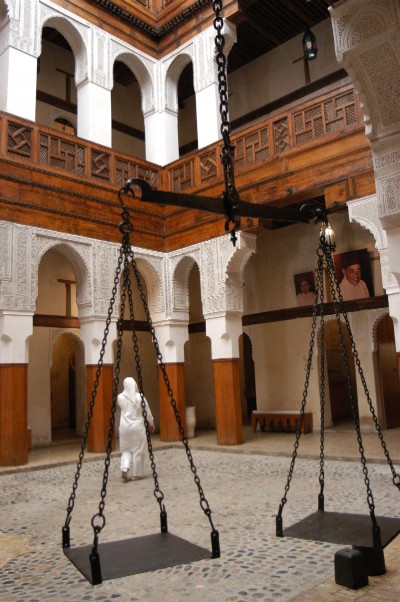 Passing all of the stalls selling offerings we reached the date sellers and bought a bag to eat while we walked. Alongside the mosque walls there were several nougat venders with carts stacked high with large chucks of pink, white and beige candy full of various nuts. We tried some of the candied sesame. Exploring new streets brought us all of the way back to the henna souk so we returned to the large mosque and tried another route. An old fire scarred medresa stood near the mosque, Medersa el-Attarine, founded in 1325 by Merenids. It was in poor shape but still had signs of its former glory with lacy stucco and wood work. Passing all of the stalls selling offerings we reached the date sellers and bought a bag to eat while we walked. Alongside the mosque walls there were several nougat venders with carts stacked high with large chucks of pink, white and beige candy full of various nuts. We tried some of the candied sesame. Exploring new streets brought us all of the way back to the henna souk so we returned to the large mosque and tried another route. An old fire scarred medresa stood near the mosque, Medersa el-Attarine, founded in 1325 by Merenids. It was in poor shape but still had signs of its former glory with lacy stucco and wood work.
Just when we thought the touts had taken the day off we had one latch onto us. He couldn't have been more than ten or twelve and wore a odd looking canvas hat with string around his chin. Our attempts to fend him off were useless. He was determined to show us the tanneries. We did want to see them but not with a tout and that was going to be an achievement. He gave us snotty faces when we tried to brush him away so we finally ended up just going about some shopping. He waited for us while we were in the shops but at the second one he got too cocky and walked about 20 meters ahead to meet us at the next intersection. When we peeked out of the shop and saw him looking the other way we bolted back in the direction we had come, out of sight, signaling  "shshsh" to the men sitting nearby with our fingers over our lips. They gave us a smile and we rushed back to the mosque before the kid knew what was happening. "shshsh" to the men sitting nearby with our fingers over our lips. They gave us a smile and we rushed back to the mosque before the kid knew what was happening.
We already knew another way to get to the tanneries and followed the sides of the mosque to the back and came at them from a different direction. A couple of police were walking ahead of us so we paced ourselves with them until they made a turn away from the tanneries. Predictably the touts swooped on us as we got close, all telling us to come this way or that way to see the tanneries saying "No charge". We ducked into the first place that offered a lookout. They were all shops and naturally hoped that people would buy things while they were there to see the tanneries. It should have given them a good edge over leather goods sold elsewhere but some decided to capitalize further by trying to charge to enter their shops. A series of interconnected touts were all trying to skim some money out of you.
The first shop was actually quite good about the whole thing and we did take time to look at their goods. The smell of the tanneries had been forewarned and it was pretty foul. Large vats of dyes were lined up behind the buildings, the reds and whites being the most visible. The various red shades were lined up in many rows of large vats that eventually gave way to rows of vats spilling over with white. Men stood in the vats up to their waits, using their legs to 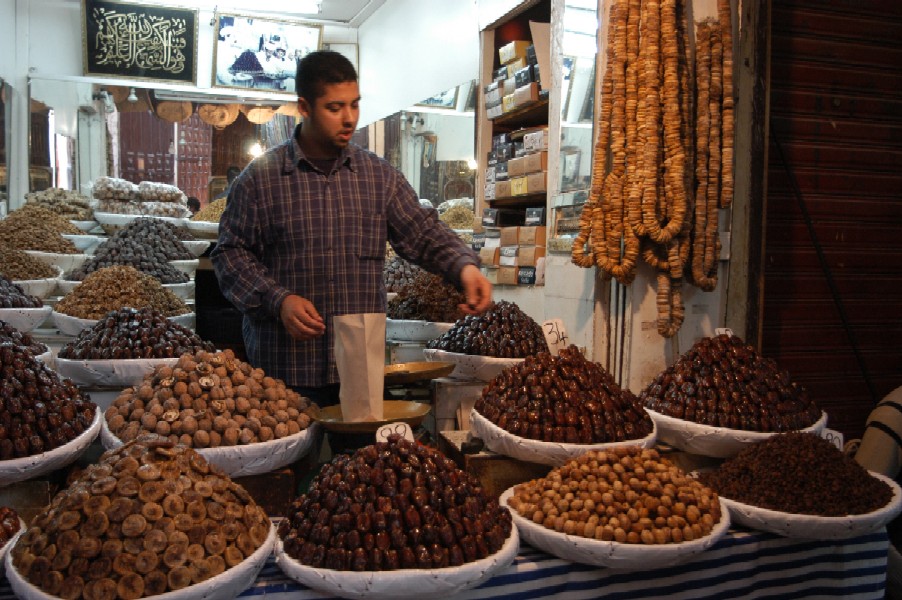 stamp the color into the animal skins. It was a craft that was no longer traditionally practiced in most of the world. Fes prided itself on maintaining the tradition but it certainly couldn't have been healthy for those doing the work. After a few minutes you began to tolerate the smells but it would be tough to live with every day. The smell undoubtedly resulted from the stench of the animal skins but the various substances used in the dyes were mixed in as well. The yellow came from saffron, orange from poppies, green from mint, red from earth, and white from pigeon dung and lime! stamp the color into the animal skins. It was a craft that was no longer traditionally practiced in most of the world. Fes prided itself on maintaining the tradition but it certainly couldn't have been healthy for those doing the work. After a few minutes you began to tolerate the smells but it would be tough to live with every day. The smell undoubtedly resulted from the stench of the animal skins but the various substances used in the dyes were mixed in as well. The yellow came from saffron, orange from poppies, green from mint, red from earth, and white from pigeon dung and lime!
From our first viewpoint we saw yellow sheep skins being dried on the roof below. The vats stretched in the opposite direction. The get a better look of the dying we found another shop close to the vats and had a look from there. A large tour group was browsing inside so we tried to  mix in with them but eventually a tout, this time an older man, saddled up alongside us and announced himself as the "guardian of the tanneries". Initially we weren't sure if he worked for the shop or not. He proceed to give us information about the tanneries but we told him "no thanks". When Rob inquired if they sold any knives we were directed to the next room and shown a rather poor selection. Upon leaving this man tried to charge us a fee. Again he said he was the "guardian of the tanneries" and, when we refused, he immediately became agitated and started calling us names. He had done nothing to earn any money. His only value was in leading us to the knife display, which the shopkeeper would have done if we had known this guy didn't work for the shop. As we walked away he yelled "What are you, Jewish?" so I turned and told him that no only was he a liar but also a racist and we kept walking. The really sad part is that if there weren't this kind of pressure we would have been more likely to buy something. As it was we felt to resentful to maintain the interest. The medieval charms of Fes were worth our visit to the city but this inevitable tout abuse made us decide that we were ready to leave. mix in with them but eventually a tout, this time an older man, saddled up alongside us and announced himself as the "guardian of the tanneries". Initially we weren't sure if he worked for the shop or not. He proceed to give us information about the tanneries but we told him "no thanks". When Rob inquired if they sold any knives we were directed to the next room and shown a rather poor selection. Upon leaving this man tried to charge us a fee. Again he said he was the "guardian of the tanneries" and, when we refused, he immediately became agitated and started calling us names. He had done nothing to earn any money. His only value was in leading us to the knife display, which the shopkeeper would have done if we had known this guy didn't work for the shop. As we walked away he yelled "What are you, Jewish?" so I turned and told him that no only was he a liar but also a racist and we kept walking. The really sad part is that if there weren't this kind of pressure we would have been more likely to buy something. As it was we felt to resentful to maintain the interest. The medieval charms of Fes were worth our visit to the city but this inevitable tout abuse made us decide that we were ready to leave.
We found our way back to our hotel from the tanneries, only picking up a big fat kid along the way. When we dismissed their offer of services the kids could get nasty and quite blatantly tried to antagonize us. If they weren't going to get your money then they were content to entertain themselves by trying to spoil your time. This kid didn't fall off until Rob actually started to walk into the 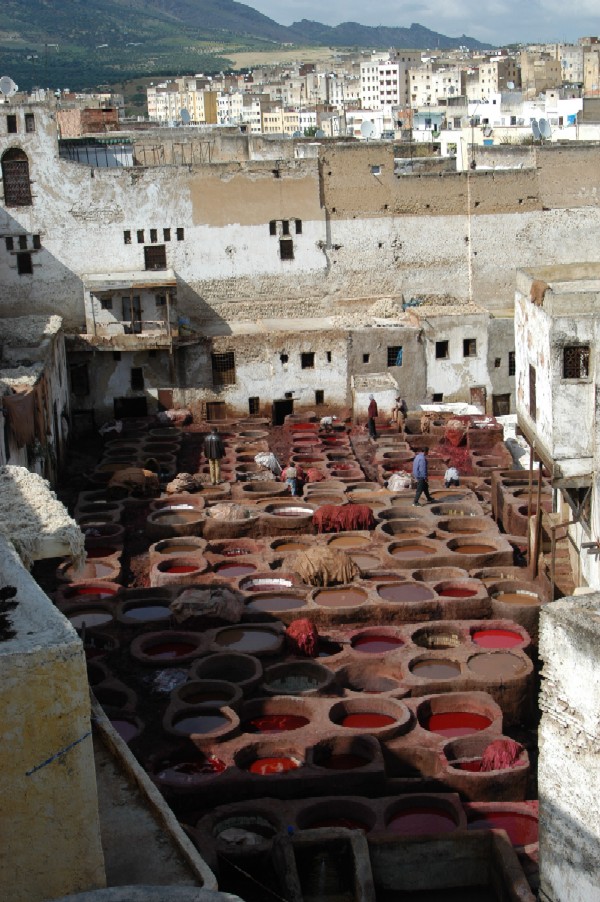 police station. The kid was cheeky and almost dared him but eventually decided not to risk it and left. police station. The kid was cheeky and almost dared him but eventually decided not to risk it and left.
After a tea break we headed to the Dar Batha Museum, the largest museum in Fes housed in an Hispano Moorish palace from late 1800s. The pottery exhibit was quite good but the palace itself didn't really live up to our expectations. The guidebook listed it as a "not to be missed" attraction. Perhaps it was our visit to the Alhambra that made the palaces in Fes less impressive to us. The Alhambra was an older example of the same style of architecture and its unmatchable location and well maintained condition made it tough to follow.
We were finally hungry after our Moroccan feast from the day before and went for dinner at the small cafe near our hotel. The man who ran it was really nice and served up some nice food, making a real effort to please. His little place was neatly decorated with red table clothes, woven placemats, and blue and white plates. He'd strung Christmas lights on this umbrellas and had flowers on the tables. We felt badly for him that his little place was eclipsed by the larger and not-so-good restaurant next door. He wasn't as aggressive at luring 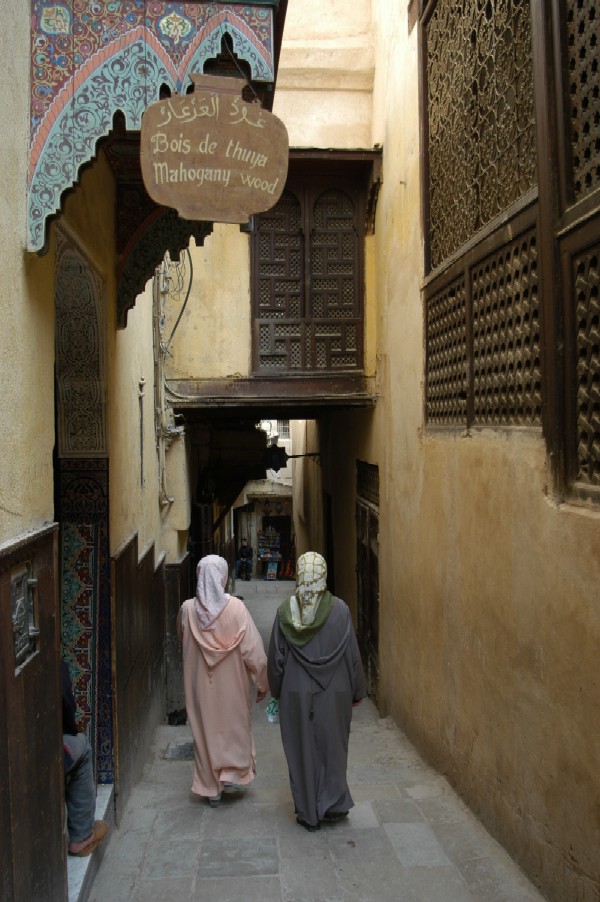 the tourists in so we took every opportunity to rave about his food to the people who slowed down as they passed. Unfortunately we never actually succeeded in getting someone to sit down right then and there but hopefully some remembered and came back later. the tourists in so we took every opportunity to rave about his food to the people who slowed down as they passed. Unfortunately we never actually succeeded in getting someone to sit down right then and there but hopefully some remembered and came back later.
Leaving the restaurant we went in for a bag of little doughnuts that a guy made by squeezing little rings out of a dough gun - very greasy but good. The people at our hotel were very nice but we were getting tired of the late night talking in the alcove outside our door.
-
Fes oldest of imperial cities.
-
founded by berbers but later populated by Al-Andalus peole and Tunisians.
-
All dynasies left a mark but most oustanding architecture is from the Merenid Dynasty (1250)
-
First Mellah in Morocco when Jews were put in one area. -meant to offer them more protection in exchange for their loyaltyl.
-
Saadian and Fes-based Wattasid dynasties followed with the latter winning power but nto for long. Alawites arrived in 1664.
-
19th century - central power crumbled and western interference increased. Fes and Marrakesh were both effectively captials and it was in Fes on 30 march 1912 tghat they treaty introducing French and Spanish protectorates over Morocco was signed.
-
French moved capital to Rabat.
-
Belghazi Musuem - 17th century palace.
-
New Fes (Fes el-Jdid).
|

